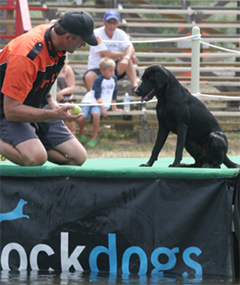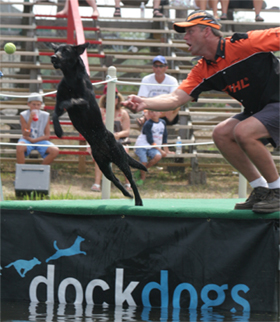| SportMutt - Premium TRAINING, PERFORMANCE and SPORTSMANSHIP for Dock Dogs, Dock Jumping Dogs, Big Air Dogs, and other Dog Performance Sports | ||||||||
|
|
|
A Toy Motivated Sport
Contributed by Tom
Dropik at SportMutt -
July 2009 |
||||||
|
I am often amazed at the natural instincts and athletic abilities of our canine companions and all the different activities available that allow them to exercise those abilities. Agility, Retriever Trials, Fly Ball, and Frisbee, to name a few, each offer their own unique challenges to these abilities as well as challenges to our abilities as Trainers and Handlers. The end result, however, is usually the same, interaction with our dogs to produce results. Dock Jumping is not unlike these other activities in that it offers its own unique challenges to the dog and handler. However, Dock Jumping is unlike the others in that the entire run takes just a few seconds to complete, depending on the discipline, and demands the most from the dogs instincts and athletic abilities in that short time. And when we’re trying to produce results, there’s no room for error. There’s definitely no time to make up distance, height, or time if an error does occur. Dogs are amazing athletes, and natural Jumpers. Just as a coaches challenge is with natural human athletes, our challenge as Trainers and Handlers is not so much that we have to teach them to be athletes, or jumpers in our case, it’s the fact that we need to teach them to exercise their natural athletic and jumping abilities. It’s been proven that traditional methods have produced great results in those other activities as well as our activities, yet I think most will agree that searching and exercising non-traditional and new methods will also produce results. I often think about how nice it would be to be able to talk to our dogs. Tell them all they have to do is run as fast as they can and jump real hard. That’s it. Unfortunately we can’t do that. So, we have to continue our efforts toward other methods to get them to do that. As part of SportMutt’s dedication to improving performance through education, we are continuously searching and exercising non-traditional methods of training that not only produce results but will also benefit the overall well being of our dogs now and well in to their senior years. As I continue my travels, watching new generations of dogs come through, talking to Trainers and Handlers from all over the country, and of course, working with my own dogs, with a goal of really understanding what makes these dogs do what they do, I’ve come to realize that Motivation plays a key role in producing results, an un-interruptible, blind ambition sort of Motivation. The common definition of Motivation can be found in any dictionary and gives us a very good definition.
Our challenge becomes how to relate that to our dogs and the sport of Dock Jumping. Now, we can sit back and think about many things that cause our dogs to act the way they do. But let’s think about why they act the way they do in the Dock Jumping arena. Is it because they love to Jump? You bet. Is it because they love to retrieve? Of course. Is it because they love to swim? No doubt about it. But what makes a dog jump over 25’ in distance, over 7’ in height, and under 6 seconds in time? There’s has to be more to it than simply wanting to jump, swim, or retrieve. I believe there is. I believe it’s all about getting the Toy. An un-interruptible desire to get the toy. What I like to call “a Predatorily Instinct to GET the Toy”. The more they want the toy the more they’ll do to get it. When people come up to me and ask me “Tom, what is it that makes these dogs jump so HUGE?”. I always seem to come back to the same answer. “They want the Toy so much; they’ll do just about anything to get it.” It’s the difference between simply wanting to jump, retrieve and swim, and doing what ever it takes get the Toy. Positive reinforcement is the key to training. However, in order for Positive reinforcement to be affective it needs to be applied immediately after an action. A “Good Dog” and a pat on the head immediately follow a good sit. A solid retrieve to hand, immediately gets an Atta-boy and a scruff of the neck. When these rewards immediately follow an action, the Dog understands why and learns to act in anticipation of that instant positive reinforcement. But when I think about instantly rewarding a HUGE Jump in the sport of dock jumping I can’t help but struggle with the concept of How. The traditional method would be to jump up and down and yell “Good Dog” so people in the next county can hear it, and I highly recommend that. Then, it’s the hugs and pats on the head after the dog walks up the ramp, and I highly recommend that. However, is that enough? Are we really rewarding for the HUGE Jump itself or are we rewarding something else? Remember, dogs need that instant positive reinforcement, and by the time the dog walks up the ramp, the jump is long gone, in their mind anyway. How in the world can we apply instant positive reinforcement, or at least make the dog associate the HUGE jump with an instant reward, when the dog is swimming 25 feet out in the water? Well this is where the Toy comes in to play. The only thing that is near the dog when that Huge Jump occurs is the Toy. The Toy becomes the instant reward. The Toy becomes the pat on the head and the scruff on the neck.
Next, identify your sessions. Identify work time and identify play time and keep these sessions separate from each other. Use the appropriate group of toys for each session. You may not always choose to work your dog, however, if you do, Always go with the work session first and reward that work session with a play session. This is where we work the basic obedience, retrieve work, and so on. This is where we use any type of reinforcement we see necessary to produce results. Play sessions are where we let loose and have fun. The only reinforcement here is Positive. If the dog is not doing something right like sitting or coming, we can’t worry about that here. We’re having fun with our Play toys. Go back to a work session and work on those things at a later time. This is phase I of perceiving the Toy as a reward. We worked hard with the Work Toys; we are now getting rewarded for that work with the play toys.
|
||||||||
|
|
||||||||
|
|
||||||||


